New HPLC, MS, and CDS Products Introduced in 2020–2021: A Brief Review
This installment of “Perspectives in Modern HPLC” describes newly introduced high-performance liquid chromatography (HPLC), mass spectrometry (MS), chromatography data systems (CDS), and related products at Pittcon 2021 and the prior year. It summarizes their significant features and user benefits.
The Pittsburgh Conference on Analytical Chemistry and Applied Spectroscopy (Pittcon) is one of the world’s largest laboratory science conferences. The 73rd Pittcon was supposed to be held at Ernest N. Morial Convention Center in New Orleans from March 8–12, 2021 but went virtual because of the Covid-19 pandemics. Nevertheless, the 2021 Pittcon technical program remained robust, with 2000+ presentations in plenary lectures, symposia (invited, award, or contributed), and poster–networking–affinity group or workshop sessions. In addition, 80+ short courses were held as webinars in a span of two weeks. The 3-day instrument exposition also went virtual, albeit with fewer than 200 exhibiting companies.
New HPLC, MS, and CDS Products in 2020–2021
In recent years, major manufacturers of HPLC instruments have turned their attention to HPLC system extensions, mass spectrometers (MS), and devices for sample preparations or injections. Table I lists new product introductions, ordered alphabetically by the vendor’s name, from 2020 to 2021, categorized as HPLC systems and modules, mass spectrometry (MS), chromatography data system (CDS), and other software. Key innovative features and benefits of each product are described.
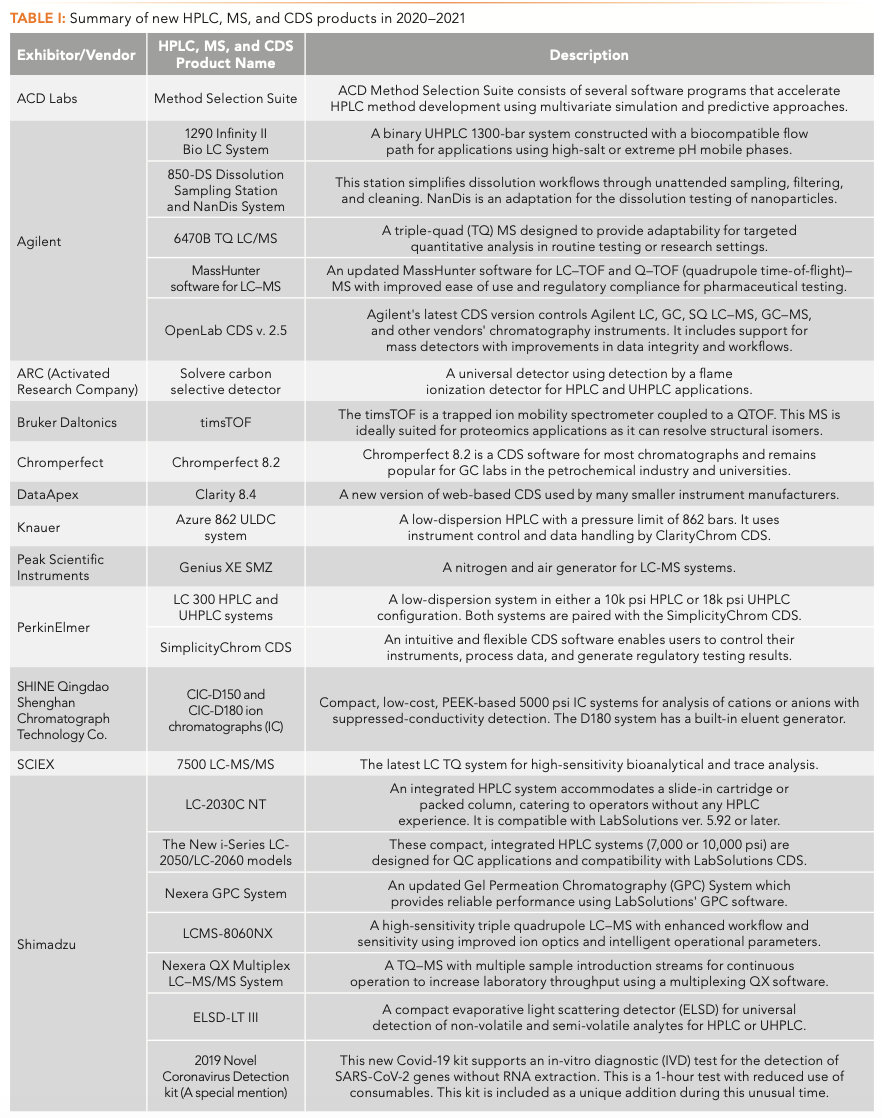
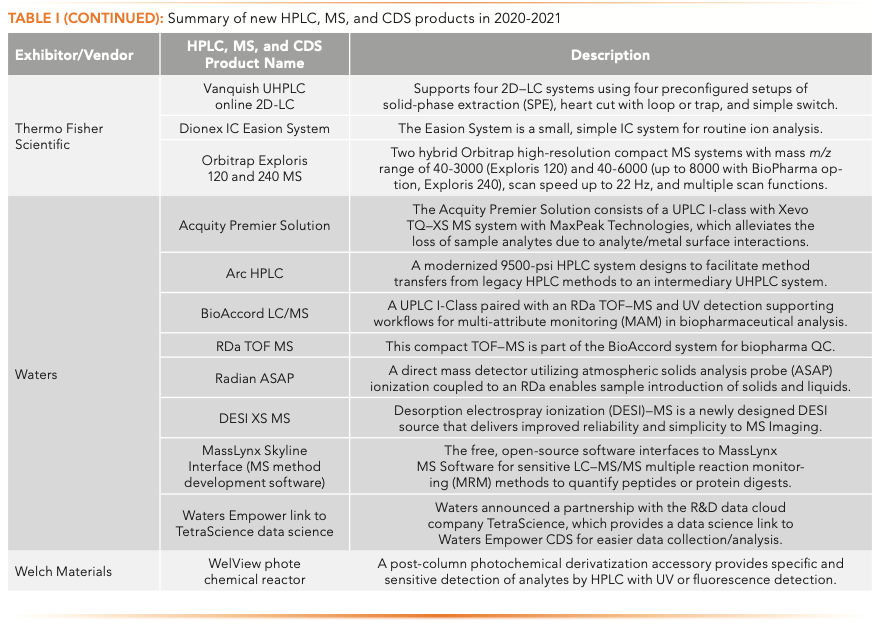
HPLC and UHPLC Systems and Line Extensions
The introduction of new ultrahigh-pressure liquid chromatography (UHPLC) systems has slowed, as manufacturers focused on HPLC line extensions for higher productivity, ease of use, and specific applications such as those for biopharmaceutical quality control applications (1).
Agilent Infinity II Bio LC System
Agilent offers an extension to the 1290 Infinity II LC family, with a 1300-bar UHPLC system with a binary pump and a flow path constructed from biocompatible materials for high-salt or extreme pH mobile phases applications.
Agilent 850-DS Dissolution Sampling Station and NanoDis System
This sampling station simplifies pharmaceutical dissolution testing workflow using automated sampling, filtering, sample collection, and cleaning. The NanoDis is an adaptation for dissolution testing of nanoparticles.
Knauer Azure 862 ULDC System
An ultra-low-dispersion HPLC system with a pressure limit of 862 bars (12,500 psi) with a binary pump and photodiode array (PDA) or ultraviolet-visible (UV-vis) detector with instrument control and data handling by ClarityChrom CDS.
PerkinElmer LC 300 HPLC and UHPLC Systems
The LC 300 system is available as a 10k psi (690 bar) HPLC or 18k psi (1240 bar) UHPLC configuration. It features an autosampler, column oven, and a choice of five detectors (PDA, multiple-wavelength, ultraviolet–visible spectrometry [UV-vis], fluorescence, and refractive index). Both systems are paired with SimplicityChrom CDS.
Shine (Qingdao Shenghan Chromatograph Technology) CIC-D150 and D180 Ion Chromatographs
The CIC-D150 and D180 are compact, low-cost, metal-free (polyether ether ketone) ion chromatographs (IC) for the analysis of cations or anions with suppressed-conductivity detection. Data handling and system control are accomplished using Clarity CDS. The performance of the CIC-D180 system for the sensitive quantitation of anions is shown in Figure 1. The D180 system has the ability for automated reagent generation for the mobile phase.
FIGURE 1: Chromatogram illustrating the sensitivity performance of the CIC-D180 in anion analysis.
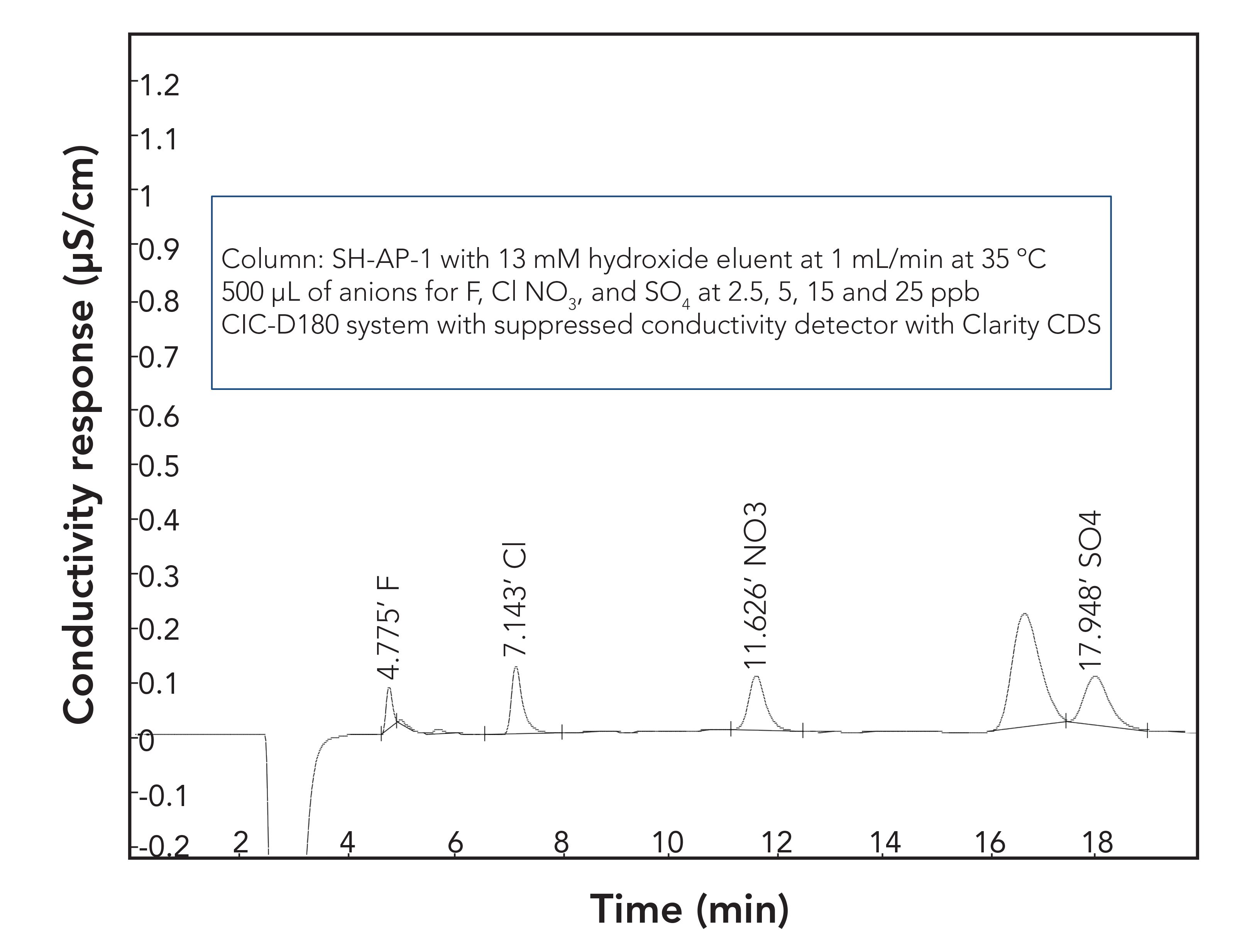
Shimadzu LC-2030C NT
The LC-2030C NT is an integrated HPLC system catering to operators with little HPLC experience. It accommodates a slide-in cartridge or packed column. The system is intuitive to operate, and has a quaternary pump, autosampler, PDA, and built-in touch panel with many automated functions (shown in the workflow diagram of Figure 2). The pressure limits are 5000 psi or 1000 psi for the packed column or slide-in cartridge, respectively (monolith-based microfluidic system that can connect directly without fittings). It is compatible with LabSolutions version 5.92 or later.
FIGURE 2: Graphics illustrating the automated workflows of the Shimadzu LC-2030C NT.
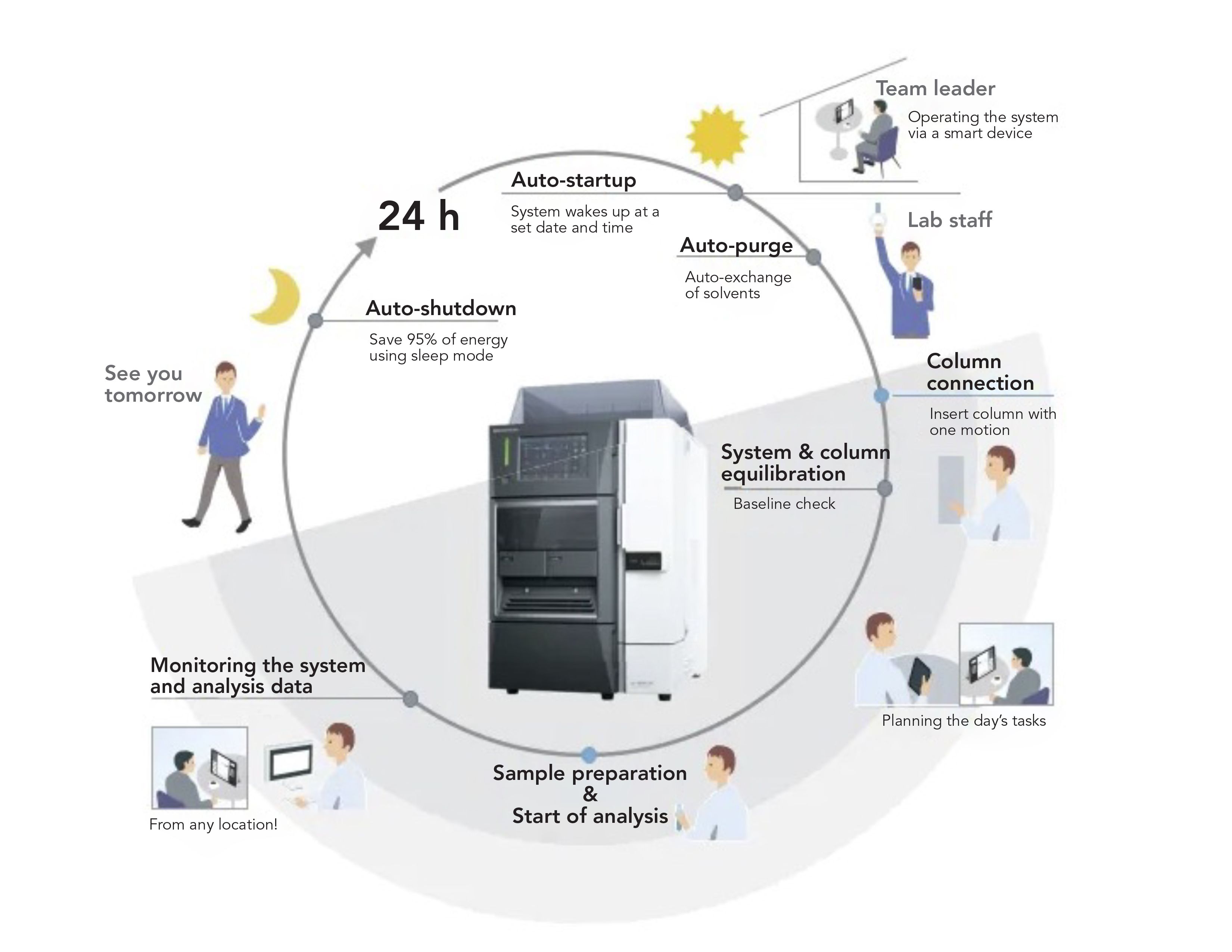
Shimadzu i-Series LC-2050 and LC-2060 Models
These compact, integrated HPLC systems (7000 or 10,000 psi; 340 or 700 bar) have low carryover (<0.0025%), and are capable of high-speed sampling (14-second injection cycle with sample capacity of 1500 samples for quality control [QC] applications). They are equipped with a built-in controller keyboard and compatibility with LabSolutions CDS. They incorporate intelligent features, such as reagent monitoring, accessing from mobile devices for remote monitoring and reanalysis and maintenance resources, and an I-PDeA II deconvolution software add-on to LabSolutions for quantitative peak areas assessment for partially resolved analytes.
Shimadzu Nexera GPC System
The Nexera GPC is an updated gel-permeation chromatography (GPC) system that provides reliable performance in many polymer characterization applications, with rapid instrument stabilization and automation capabilities using LabSolutions GPC software.
Thermo Scientific Vanquish UHPLC Online 2D-LC
The updated Vanquish online 2D-LC supports four preconfigured setups to improve the analysis of complex samples, including solid-phase extraction (SPE), heart cut analysis with either a loop or trap, and simple column switching. This setup allows seamless switching between a Vanquish Trap Heart-Cut 2D-LC instrument and a Thermo Scientific Vanquish Duo UHPLC system for Dual LC.
Thermo Scientific Vanquish Core HPLC System
Built on the Vanquish platform, the Vanquish Core HPLC system enables labs to evolve to meet current, and future, needs, with a pressure limit up to 70 MPa (10,000 psi). New technology, such as System Health Monitoring and the Vanquish Solvent Monitor, provide increased productive time. An integrated display and detailed maintenance videos empower operators to maintain high-quality results. A full suite of method transfer tools, including tunable gradient delay volume, makes adoption easy.
Thermo Dionex IC Easion System
The Easion is a small, simple ion chromatograph designed for routine ion analysis.
Waters Acquity Premier Solution
The Acquity Premier Solution consists of Quan recovery vials and plates, acquity premier columns, and the acquity premier UPLC (UHPLC). All contain Waters MaxPeak high performance surfaces (HPS) that reduce interactions between metal-sensitive analytes and those affected by nonspecific binding. Columns come in a variety of chemistries. The UPLC can be binary or quaternary and couples with Waters tropospheric ultraviolet (TUV), eLamda PDA, fluorescence, and MS detectors—including triple quad and time-of-flight (TOF) technologies. It is designed for pharmaceutical and biomedical research analysis of organic acids, organophosphates, oligonucleotides, acidic glycans, and phospholipids by reversed-phase chromatography and hydrophilic interaction chromatography (HILIC).
Waters Arc HPLC System
A modernized 9500-psi HPLC system with dual flow paths seamlessly receives legacy HPLC methods to an intermediary UHPLC system with low analyte carryover and high precision, while preserving analyte retention and reproducibility. This system is supported on compliance-ready Empower CDS.
HPLC Modules
ARC (Activated Research Company) Solvere Carbon Selective Detector
The Solvere carbon selective detector is a universal detector using a flame ionization detector (FID) that converts compounds with carbon atoms into methane for HPLC and UHPLC applications. It is capable of a linear dynamic range of five orders of magnitude, from 10 ppm to 100%, and allows an absolute calibration approach using a sucrose reference standard. The detector is compatible with most MS-compatible mobile phases at flow rates of 0.3-0.5 mL/min. It is applicable to proteins, polymers, sugars, and other non-volatile carbon-containing analytes.
Shimadzu ELSD-LT III
This is a new compact evaporative light scattering detector for universal detection of non-volatile and semi-volatile analytes for HPLC or UHPLC applications.
Welch Materials WelView Photochemical Reactor
This post-column photochemical derivatization accessory provides more specific and sensitive detection (ppb) of analytes, such as aflatoxins or sulfa drugs, by HPLC with UV or fluorescence detection.
Mass Spectrometers (MS)
The marketing landscape for mass spectrometers has been described elsewhere (1,2). Manufacturers continued to upgrade their product offerings in TOF, triple quadrupole MS and orbitraps, and sample introduction systems to increase productivity for solid–liquid sampling and imaging. One of the emerging trends in MS applications is the use of high-resolution MS in the quality control and characterization of biopharmaceutical therapeutics (2).
Agilent 6470B TQ LC–MS
The 6470B triple quadrupole LC–MS is designed to provide adaptability for targeted quantitative analysis with multiple ion sources (ESI, AJS [jet stream], APCI, MMI, and NanoESI) in routine testing or research settings. It provides high-sensitivity analyses with a wide linear dynamic range, and supports a multiple reaction monitoring (MRM) speed of 500 transitions/s, a mass range of 5–3000 m/z, and a scan speed of 17000 Da/s.
Bruker Daltonics timsTOF
The timsTOF is trapped ion mobility spectrometry coupled to a quadrupole time-of-flight (QTOF) that provides an additional dimension of separation based on shape and size (collisional cross section with a resolution of ~200). Sensitivity is enhanced by a gas-phase ion enrichment process. The QTOF–MS has a resolution of 60,000 and a mass accuracy of 2 ppm. It is ideally suited for proteomics applications.
Peak Scientific Instruments Genius XE SMZ
Peak introduced the Genius XE SMZ, a nitrogen and air generator for Shimadzu LC–MS and other systems.
SCIEX Triple Quad 7500 LC–MS/MS System
Sciex TQ 7500 LC–MS/MS sets a new standard for high-sensitivity bioanalytical and trace analysis. It supports a scan speed of 12,000 Da/s, mass range 5–2000 m/z, and six orders of magnitude in linearity. It is Q-trap ready, and uses Sciex Operating System v.2.0 or higher software.
Shimadzu LCMS-8060NX
The 8060NX is a new high-sensitivity triple quadrupole LC–MS with improved workflow efficiency. It supports multiple ion sources and has a mass range of 2–2000 m/z, resolution of 0.7 FWHM, mass accuracy of 0.1 Da, and a scan speed of 30000 Da/s. The LabSolution LCMS workstation is used to perform system control and data handling.
Shimadzu Nexera QX Multiplex LC–MS/MS System
The Nexera QX Multiplex LC–MS/MS System is a triple quadrupole MS with multiple, alternating UHPLC sample introduction streams (two or more channels), for continuous operation to increase laboratory throughput using a multiplexing QX software.
Thermo Scientific Orbitrap Exploris 120 and 240 MS
The Exploris 120 and 240 MS are hybrids single quad-orbitrap MS systems, with a mass range of 40–3000 or 40–6000 Da (up to 8000 with BioPharma option, Exploris 240), scan speed up to 22 Hz, and multiple scan functions. The high-resolution MS systems benefit small molecule researchers in high-throughput screening, metabolomics, environmental analysis, metabolite identification, and forensic toxicology.
Waters BioAccord LC–MS System
BioAccord features an Acquity I-Class UPLC paired with a Waters RDa TOF MS and UV or fluorescence detector. It is dedicated to supported workflows for the intact mass of proteins and oligonucleotides, peptide mapping and multi-attribute method (MAM), and release N-glycan analysis. The system is compliance-ready, and sup- ported on Waters connect and Unifi Scientific Information System.
Waters RDa Smart TOF–MS
This compact TOF–MS (same MS technology as the BioAccord) is user-friendly. It is dedicated to supporting small molecule workflows for impurity analysis, forced degradation, lipid screening, natural products profiling, food contaminant analysis, seized drug analysis, and profiling. This system allows for Tunable UV and PDA detection. It is compliance-ready, and is supported on waters_connect.
Radian ASAP Direct Mass Detector
A direct mass quadrupole detector utilizing atmospheric solids analysis probe (ASAP) ionization, Radian ASAP enables sample introduction of solids and liquids. This system is supported by MassLynx, Ion Lynx, and Live ID software.
Waters DESI XS MS
Desorption Electrospray Ionization (DESI) MS is a newly designed source that delivers improved reliability and simplicity to MS Imaging.
Chromatography Data System (CDS) and Other Software Products
The CDS marketing landscape has been described elsewhere (3).
ACD Labs Method Selection Suite
ACD Method Selection Suite consists of several software programs that accelerate HPLC method development using LC Simulator 1D, 2D, and 3D (multivariate approach), allowing simultaneous optimization of multiple factors (gradient time, temperature, pH, gradient segments, and so on) Also, the physicochemical properties of the analytes can be used for predictions.
Agilent MassHunter Software for LC–MS
An updated MassHunter software for LC–TOF and QTOF for ease of use and better compliance to regulatory requirements in pharma or biopharma quality control laboratories.
Agilent OpenLab CDS v. 2.5
This is the latest version of Agilent’s CDS for control Agilent’s LC, GC, SQ LC–MS, GC–MS, and other vendors’ chromatographs. The new version includes enhanced support for mass detectors, focusing on data integrity and pharmaceutical workflows.
Chromperfect 8.2 CDS
Chromperfect 8.2 for Windows 10 is CDS software for data acquisition and instrument control using a PC workstation or client-service network. It is compatible with most chromatographs, including older Agilent GC instruments, and remains popular for GC labs in the petrochemical industry and universities.
Clarity DataApex 8.4 CDS
DataApex 8.4 is a new version of the web-based and 21 CFR Part 11 compliant CDS used by many smaller instrument manufacturers.
PerkinElmer SimplicityChrom CDS
SimplicityChrom is an intuitive and flexible CDS that enables users to control their instruments, process data, and generate 21 CFR Part 11 compliant results.
Waters MassLynx Skyline Interface (MS Method Development Software)
This is free, open-source software that interfaces to MassLynx MS Software for the development of sensitive LC–MS/MS MRM methods to quantify peptides or protein digests.
Waters Empower Link to TetraScience Data Science
Waters announced a partnership with the leading R&D data cloud company TetraScience, which provides a Data Science Link to Waters Empower CDS for easier data collection and analysis in speeding up project timelines.
A Special Mention: Covid-19 Test Kit from Shimadzu
Shimadzu 2019 Novel Coronavirus Detection kit supports an in vitro diagnostic (IVD) test for the qualitative detection of SARS-CoV-2 genes using real-time polymerase chain reaction (RT-PCR). This is a 1-hour test with reduced use of consumables. (Note: This Covid-19 PCR detection kit from Shimadzu is of particular interest, and is included here even though it is not based on separation science.) This RNA extraction free test kit is undergoing reviews by the U.S. Food and Drug administration (FDA).
Summary and Commentaries
Pittcon 2021 will be remembered as the first virtual Pittsburgh Conference in the history of the series. The technical program remained robust, albeit a significant reduction in the number of conferees and exhibitors. A brief description of my five days at the virtual Pittcon 2021 can be found elsewhere (4). The Pittcon committee did an outstanding job transforming the conference and exposition into a virtual format using a web-based platform (Labroots). The platform appeared to work well, accommodating easy navigation of multiple venues with high-resolution graphical and video support (a screen print of the landing page or the conference lobby’s main menu is shown in Figure 3). Initially, my attitude towards the virtual format was decidedly negative, but it turned around entirely towards the conference’s end after realizing its many benefits. However, I was disappointed by the virtual exposition, as most booths were understaffed, and immediate connections with sales representatives were difficult. I am still heartbroken about abandoning this premier conference by some major manufacturers, such as Agilent, Waters, and Sciex. Their reasons for skipping Pittcon and missing out on the opportunities to engage with thousands of potential customers and competitors continue to be elusive.
FIGURE 3: The landing page (main menu) of the web-based platform allowing quick navigation to all venues and events at Pittcon 2021.

The long-term impact of the pandemics on the travel and conference industries remains to be seen. The availability of vaccines gave us a glimmer of light at the end of a dark tunnel. I am hopeful that Pittcon will adopt an improved hybrid format for all future venues incorporating both on-site and virtual platforms.
See everyone at Pittcon 2022 in Atlanta!
Acknowledgments
The author thanks the marketing staff of all manufacturers who provided timely responses to the LCGC questionnaires. I was grateful to the eight sales representatives that I connected with at the virtual exposition to obtain last-minute information on their new products: Shimadzu, PerkinElmer, ACD Lab, Advion, Bruker Daltonics, Chromperfect, Axcend, and LabTech. This article’s content is the author’s opinions gathered from the open literature, websites, and personal networking. They bear no relationship to those from LCGC, Pittcon, or any other organizations.
Special thanks to my reviewers, Barry Boyes at AMT, Giacomo Chiti at Bolton HPC, Alice Krumenaker at TW Metals, Mike Shifflet at J&J Consumer Health Care, Carsten Paul at Thermo Fisher Scientific, Elisabeth Bergman at Waters, and Bo Yan at Beam Therapeutics, who provided me with prompt editorial input to this installment’s accuracy and clarity.
References
(1) M.W. Dong, LCGC North Am. 37(4), 252–259 (2019).
(2) M.W. Dong, HPLC and UHPLC for Practicing Scientists (John Wiley & Sons, Hobo- ken, New Jersey, 2nd Ed., 2019).
(3) R. Mazzarese, S. M. Bird, P.J. Zipfell, and M.W. Dong, LCGC North Am. 37(12), 852–866 (2019).
(4) “Five Days of Virtual Pittcon 2021” | LinkedIn https://www.linkedin.com/pulse/five-days-virtual-pittcon-2021-michael-dong-%25E5%2594%2590%25E7%25BA%25AC%25E4%25B8%25AD/?trackingId=%2FvplpidBa%2Bh3OR9Jy%2FZSFQ%3D%3D
ABOUT THE AUTHOR
Michael W. Dong is a principal of MWD Consulting, which provides training and consulting services in HPLC and UHPLC, method improvements, pharmaceutical analysis, and drug quality. He was formerly a Senior Scientist at Genentech, Research Fellow at Purdue Pharma, and Senior Staff Scientist at Applied Biosystems/PerkinElmer. He holds a PhD in Analytical Chemistry from City University of New York. He has more than 130 publications and a best-selling book in chromatography. He is an editorial advisory board member of LCGC North America and the Chinese American Chromatography Association. Direct correspondence to: LCGCedit@mmhgroup.com.

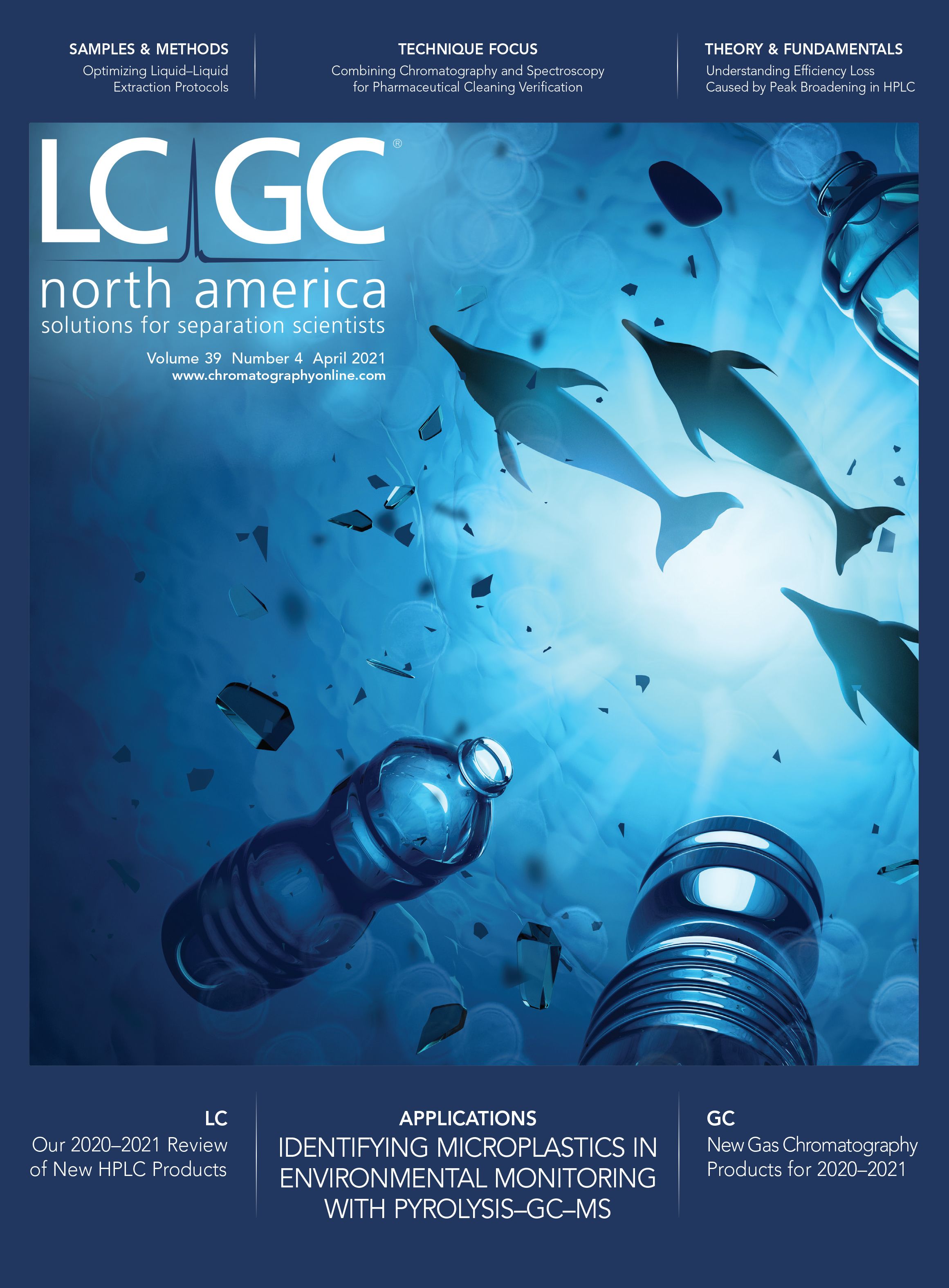
Common Challenges in Nitrosamine Analysis: An LCGC International Peer Exchange
April 15th 2025A recent roundtable discussion featuring Aloka Srinivasan of Raaha, Mayank Bhanti of the United States Pharmacopeia (USP), and Amber Burch of Purisys discussed the challenges surrounding nitrosamine analysis in pharmaceuticals.
Extracting Estrogenic Hormones Using Rotating Disk and Modified Clays
April 14th 2025University of Caldas and University of Chile researchers extracted estrogenic hormones from wastewater samples using rotating disk sorption extraction. After extraction, the concentrated analytes were measured using liquid chromatography coupled with photodiode array detection (HPLC-PDA).
Silvia Radenkovic on Building Connections in the Scientific Community
April 11th 2025In the second part of our conversation with Silvia Radenkovic, she shares insights into her involvement in scientific organizations and offers advice for young scientists looking to engage more in scientific organizations.













